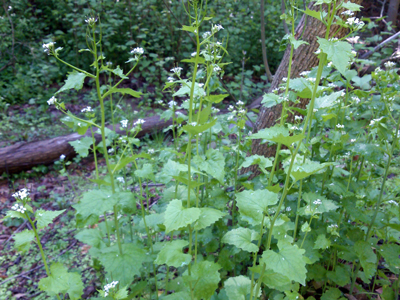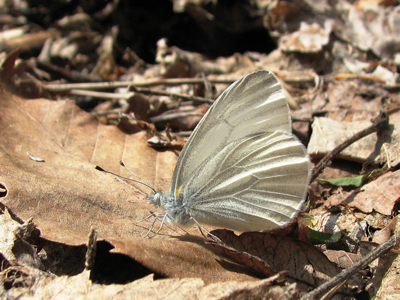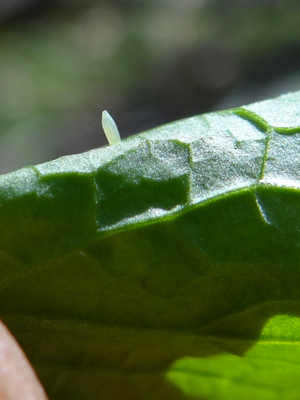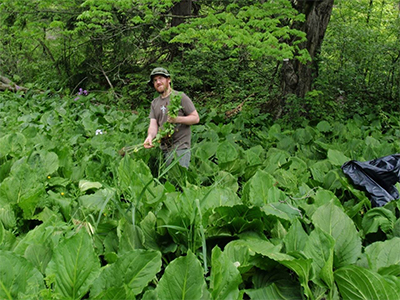Conservation Science
Protecting Pennsylvania’s Plants and Animals
Garlic Mustard and the
West Virginia White Butterfly
One of many invasive plants in Pennsylvania, garlic mustard (Alliaria petiolata) was introduced on the east coast in the 1860s and has since spread throughout the Northeast and Midwest. This shade-tolerant invasive plant outcompetes native vegetation. It also acts as a toxic decoy to the West Virginia white (Pieris virginiensis) butterfly, a delicate and rare spring-flying butterfly native to the region. The Western Pennsylvania Conservancy is combating the spread of garlic mustard on its properties with the hopes of protecting this important butterfly.

Garlic mustard is a biennial herb that prefers moist, shaded areas. An aggressive invader, garlic mustard tends to spread quickly along roads, trails and streams, and then moves into adjacent forest. Garlic mustard also grows densely, crowding out native plants. Many of those native forest plants extend the reach of their root networks by growing symbiotically with soil fungi. Garlic mustard has no such fungal partners and uses “chemical warfare” to poison the fungal associates of competing plants. This gives garlic mustard an advantage over those plants.
West Virginia White Butterfly
 The West Virginia white is a delicate and rare spring-flying butterfly native to Pennsylvania. It flies for about a month each spring, from mid-April to mid-May. The caterpillars can eat several species of spring ephemeral plants in the mustard family, though in this region they mostly rely on two-leaved toothwort (Cardamine diphylla).
The West Virginia white is a delicate and rare spring-flying butterfly native to Pennsylvania. It flies for about a month each spring, from mid-April to mid-May. The caterpillars can eat several species of spring ephemeral plants in the mustard family, though in this region they mostly rely on two-leaved toothwort (Cardamine diphylla).
The butterfly once ranged through the northern and western parts of the commonwealth, with only scattered records in southeastern counties. Unfortunately, West Virginia white populations have decreased, mostly due to the spread of garlic mustard.
A Toxic Decoy for the West Virginia White Butterfly
The most serious of several threats that garlic mustard poses to these butterflies is when it acts as a toxic decoy. Garlic mustard is in the mustard family – the same family of plants that contains the butterfly’s preferred plant, toothworts. Garlic mustard and toothworts are similar enough in chemistry that butterflies become confused and lay their eggs on garlic mustard. However, the chemistry of the plants is different enough that their caterpillars always die.
 Garlic mustard also affects the West Virginia white by displacing its host plants and its nectar sources. Even though garlic mustard itself is a good source of nectar, it does not bloom when the butterflies first emerge in mid-April. The butterflies require diverse, abundant wildflowers with staggered blooming times to provide nectar throughout the month-long period when they fly.
Garlic mustard also affects the West Virginia white by displacing its host plants and its nectar sources. Even though garlic mustard itself is a good source of nectar, it does not bloom when the butterflies first emerge in mid-April. The butterflies require diverse, abundant wildflowers with staggered blooming times to provide nectar throughout the month-long period when they fly.
As if this wasn’t enough, there are numerous other threats to the West Virginia white butterfly including habitat loss. Because these butterflies stay in the forest and don’t cross open areas or even wide roads, they are especially sensitive to forest fragmentation. When populations become small and isolated, they are not able to recolonize habitat patches and tend to die out over time. Even heavy selective timber cutting will render habitat unsuitable for the butterflies.
Heavy deer browse is also a problem because it causes the loss of host and nectar plants. Gypsy moth spraying kills West Virginia white caterpillars, which are vulnerable to the bacteria used to kill gypsy moth caterpillars.
Controlling Garlic Mustard in PA
 WPC biologists are documenting West Virginia white populations throughout their Pennsylvania range. We collect baseline data on each population and identify sites that would benefit from conservation and management.
WPC biologists are documenting West Virginia white populations throughout their Pennsylvania range. We collect baseline data on each population and identify sites that would benefit from conservation and management.
The Conservancy is also actively managing invasive plants on the three of its properties where West Virginia whites are known to occur: Bear Run Nature Reserve, Wolf Creek Narrows, and Lake Pleasant. WPC is active in regional cooperative efforts to control exotic invasive plants, through the Lake Erie Watershed Cooperative Weed Management Management Area, and the Southern Laurel Highlands Plant Management Partnership.
